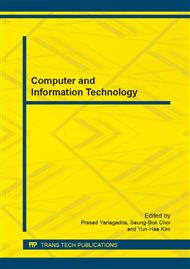[1]
Crisp, D.J., The state-of-the-art in ship detection in synthetic aperture radar imagery, 2004, DTIC Document.
Google Scholar
[2]
Migliaccio, M., A. Gambardella and F. Nunziata. Ship detection over single-look complex SAR images[C]. in US/EU-Baltic International Symposium, 2008 IEEE/OES. 2008. IEEE.
DOI: 10.1109/baltic.2008.4625554
Google Scholar
[3]
Velotto, D., M. Soccorsi and S. Lehner. Azimuth ambiguities removal for ship detection using full polarimetric X-band SAR data[C]. in Geoscience and Remote Sensing Symposium (IGARSS), 2012 IEEE International. 2012. IEEE.
DOI: 10.1109/igarss.2012.6351863
Google Scholar
[4]
Gambardella, A., F. Nunziata and M. Migliaccio, A physical full-resolution SAR ship detection filter[J]. Geoscience and Remote Sensing Letters, IEEE, 2008. 5(4): pp.760-763.
DOI: 10.1109/lgrs.2008.2005255
Google Scholar
[5]
Zhang, X., et al., A novel polarimetric SAR ship detection filter[J]. (2013).
Google Scholar
[6]
Corbane, C., et al., A complete processing chain for ship detection using optical satellite imagery[J]. International Journal of Remote Sensing, 2010. 31(22): pp.5837-5854.
DOI: 10.1080/01431161.2010.512310
Google Scholar
[7]
Proia, N. and V. Pagé, Characterization of a bayesian ship detection method in optical satellite images[J]. Geoscience and Remote Sensing Letters, IEEE, 2010. 7(2): pp.226-230.
DOI: 10.1109/lgrs.2009.2031826
Google Scholar
[8]
Chen, F., et al. Graph-based ship extraction scheme for optical satellite image[C]. in Geoscience and Remote Sensing Symposium (IGARSS), 2011 IEEE International. 2011. IEEE.
DOI: 10.1109/igarss.2011.6049172
Google Scholar
[9]
Guang, Y., L. Qichao and G. Feng. A Novel Ship Detection Method Based on Sea State Analysis from Optical Imagery[C]. in Image and Graphics (ICIG), 2011 Sixth International Conference on. 2011. IEEE.
DOI: 10.1109/icig.2011.19
Google Scholar
[10]
Wolfe, J.M. and T.S. Horowitz, What attributes guide the deployment of visual attention and how do they do it?[J]. Nature Reviews Neuroscience, 2004. 5(6): pp.495-501.
DOI: 10.1038/nrn1411
Google Scholar
[11]
Riesenhuber, M. and T. Poggio, Hierarchical models of object recognition in cortex[J]. Nature neuroscience, 1999. 2(11): pp.1019-1025.
DOI: 10.1038/14819
Google Scholar
[12]
Mannan, S.K., C. Kennard and M. Husain, The role of visual salience in directing eye movements in visual object agnosia[J]. Current biology, 2009. 19(6): p. R247-R248.
DOI: 10.1016/j.cub.2009.02.020
Google Scholar
[13]
Chen, T., et al. Sketch2Photo: internet image montage[C]. in ACM Transactions on Graphics (TOG). 2009. ACM.
Google Scholar
[14]
Rutishauser, U., et al. Is bottom-up attention useful for object recognition?[C]. in Computer Vision and Pattern Recognition, 2004. CVPR 2004. Proceedings of the 2004 IEEE Computer Society Conference on. 2004. IEEE.
DOI: 10.1109/cvpr.2004.1315142
Google Scholar
[15]
Han, J., et al., Unsupervised extraction of visual attention objects in color images[J]. Circuits and Systems for Video Technology, IEEE Transactions on, 2006. 16(1): pp.141-145.
DOI: 10.1109/tcsvt.2005.859028
Google Scholar
[16]
LI, D., X. HU and X. ZHU, Visual Contrast Based Saliency Map Generation and Object Detection[J]. Geomatics and Information Science of Wuhan University, 2012. 37(4): pp.379-383.
Google Scholar


